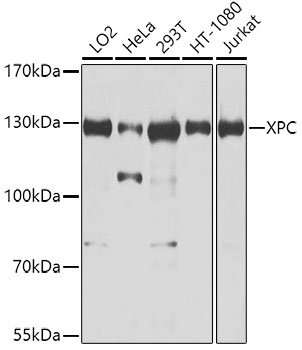XPC antibody [3.26]
GTX70294
ApplicationsImmunoFluorescence, Western Blot, ImmunoCytoChemistry, ImmunoHistoChemistry, ImmunoHistoChemistry Paraffin
Product group Antibodies
ReactivityHuman, Mouse
TargetXPC
Overview
- SupplierGeneTex
- Product NameXPC antibody [3.26]
- Delivery Days Customer9
- Application Supplier NoteWB: 1:500-1:3000. ICC/IF: 1:100-1:1000. *Optimal dilutions/concentrations should be determined by the researcher.Not tested in other applications.
- ApplicationsImmunoFluorescence, Western Blot, ImmunoCytoChemistry, ImmunoHistoChemistry, ImmunoHistoChemistry Paraffin
- CertificationResearch Use Only
- ClonalityMonoclonal
- Clone ID3.26
- Concentration1.15 mg/ml
- ConjugateUnconjugated
- Gene ID7508
- Target nameXPC
- Target descriptionXPC complex subunit, DNA damage recognition and repair factor
- Target synonymsRAD4, XP3, XPCC, p125, DNA repair protein complementing XP-C cells, mutant xeroderma pigmentosum group C, xeroderma pigmentosum, complementation group C
- HostMouse
- IsotypeIgG1
- Protein IDQ01831
- Protein NameDNA repair protein complementing XP-C cells
- Scientific DescriptionThe protein encoded by this gene is a key component of the XPC complex, which plays an important role in the early steps of global genome nucleotide excision repair (NER). The encoded protein is important for damage sensing and DNA binding, and shows a preference for single-stranded DNA. Mutations in this gene or some other NER components can result in Xeroderma pigmentosum, a rare autosomal recessive disorder characterized by increased sensitivity to sunlight with the development of carcinomas at an early age. Alternatively spliced transcript variants have been found for this gene. [provided by RefSeq, Aug 2017]
- ReactivityHuman, Mouse
- Storage Instruction-20°C or -80°C,2°C to 8°C
- UNSPSC12352203
References
- de Semir D, Bezrookove V, Nosrati M, et al. Nuclear Receptor Coactivator NCOA3 Regulates UV Radiation-Induced DNA Damage and Melanoma Susceptibility. Cancer Res. 2021,81(11):2956-2969. doi: 10.1158/0008-5472.CAN-20-3450Read this paper
- Wang YC, Huang JL, Lee KW, et al. Downregulation of the DNA Repair Gene DDB2 by Arecoline Is through p53's DNA-Binding Domain and Is Correlated with Poor Outcome of Head and Neck Cancer Patients with Betel Quid Consumption. Cancers (Basel). 2020,12(8). doi: 10.3390/cancers12082053Read this paper
- Pavey S, Pinder A, Fernando W, et al. Multiple interaction nodes define the postreplication repair response to UV-induced DNA damage that is defective in melanomas and correlated with UV signature mutation load. Mol Oncol. 2020,14(1):22-41. doi: 10.1002/1878-0261.12601Read this paper
- Sears CR, Zhou H, Justice MJ, et al. Xeroderma Pigmentosum Group C Deficiency Alters Cigarette Smoke DNA Damage Cell Fate and Accelerates Emphysema Development. Am J Respir Cell Mol Biol. 2018,58(3):402-411. doi: 10.1165/rcmb.2017-0251OCRead this paper
- Jia L, Yan F, Cao W, et al. Dysregulation of CUL4A and CUL4B Ubiquitin Ligases in Lung Cancer. J Biol Chem. 2017,292(7):2966-2978. doi: 10.1074/jbc.M116.765230Read this paper
- Dong TK, Ona K, Scandurra AE, et al. Deficient Nucleotide Excision Repair in Squamous Cell Carcinoma Cells. Photochem Photobiol. 2016,92(5):760-6. doi: 10.1111/php.12625Read this paper
- Kim H, Dejsuphong D, Adelmant G, et al. Transcriptional repressor ZBTB1 promotes chromatin remodeling and translesion DNA synthesis. Mol Cell. 2014,54(1):107-118. doi: 10.1016/j.molcel.2014.02.017Read this paper
- Ramamoorthy M, May A, Tadokoro T, et al. The RecQ helicase RECQL5 participates in psoralen-induced interstrand cross-link repair. Carcinogenesis. 2013,34(10):2218-30. doi: 10.1093/carcin/bgt183Read this paper
- Demetriou SK, Ona-Vu K, Sullivan EM, et al. Defective DNA repair and cell cycle arrest in cells expressing Merkel cell polyomavirus T antigen. Int J Cancer. 2012,131(8):1818-27. doi: 10.1002/ijc.27440Read this paper
- de Feraudy S, Ridd K, Richards LM, et al. The DNA damage-binding protein XPC is a frequent target for inactivation in squamous cell carcinomas. Am J Pathol. 2010,177(2):555-62. doi: 10.2353/ajpath.2010.090925Read this paper



